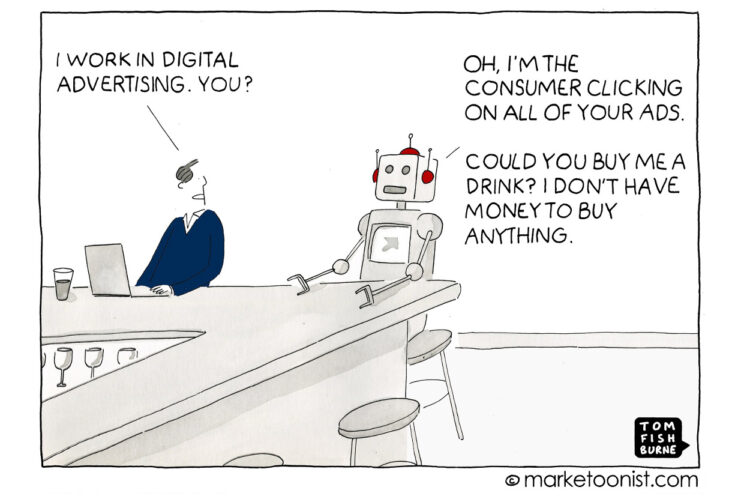How an 'umbrella' model can stop bots eating media budgets

Opinion
The path to improvement is clear: focus on in-target groups.
In a recent piece for The Media Leader, my collaborator Brian Jacobs highlighted how bots are eating ad budgets to an unacceptable degree. Most accept that this is a problem; the issue now is what to do about it.
To start at the beginning, assessing effect by looking at gross impressions, likes, Retweets and the rest, is less than insightful. If many interactions come from bots or non-human activities, then we are deluding ourselves. The data generated may have the veneer of accountability but, really, it is largely meaningless.
Measuring effect properly means taking account of indirect consequences. Search results or increases in online purchases will likely be affected by offline spend. The best way of truly understanding the effect on any business is to build a model that can disentangle the impact that multiple activities have on the outcome.
In our experience, models can be developed that take bots out of the equation and explain how to optimise real world results. Here’s how to go about it.
Start with the right outcome
We recommend building around sales or some other metric that involves real people spending real money to buy products or services.
The focus needs to be on both on and offline activities and sales. In our experience, building around online only gives a skewed view of the world; online activities can clearly benefit the whole company, not just the ecommerce group. After all, everything communicates.
Embrace holistic attribution
Ask yourself, what drives sales at my company? For each answer, find data that can represent this factor in the model. The upfront discovery phase is vital; asking the right questions, understanding what is known and what isn’t is key.
The final model, which we can call an “umbrella model”, should represent both online and offline media, as well as other factors that could move sales. Paid, earned and owned media should all be there.
Targeting for online success
From this “umbrella model”, you need to extract information that allows you to target online media, using variables accessible on each platform. Our models combine geography, time and audience construction to do this; consider these but test others.
You can also build complimentary models for specific platforms that use more of the targeting options available to that platform. The platform model needs to be compatible with the umbrella model or you will pick up bot traffic.
Validate
Many online attribution tools cannot be validated. Avoid these. Instead, use your model to test its predictions against real world outcomes and adjust as needed.
In testing, our models usually explain over 90% of the variation we see in outcomes by audience decile, giving us confidence that we are doing the right thing.
Models are never finished; keep checking accuracy with each campaign, using well designed tests; it will pay dividends as you scale.
Using this approach we built a model for a telco client for a campaign designed to acquire new customers. Channels included both search and online display.
We found a significant difference in the activation rates (number of customers divided by households) between groups that we had as highly likely to buy (and therefore targeted) and those that scored much lower:
Targeting higher scoring groups led to an activation rate that was 2.1 times higher than recorded for other parts of the audience.
The overall campaign based on chasing clicks, saw 70% of the budget go to low, out of target groups.
The path to improvement is clear: focus on in-target groups. Given the online inventory available, the entire budget should be spent there to secure much better outcomes, if fewer clicks.
Chasing low-cost inventory may deliver against clicks, but clients would rather sell more stuff than achieve more clicks. However cheap the inventory.
In the battle against bots, we can have our cake and eat it too. We can keep money out of the hands of unscrupulous bot owners and place it in the hands of reputable online publishers. This improves performance as we are selling to real people who have a genuine interest in what we have to say. Win-win.
David Beaton is senior partner and co-owner of Navigation ME (Marketing Effectively) and co-founder of the Crater Lake & Co agency collective




